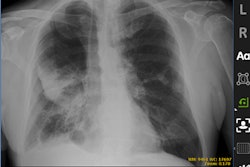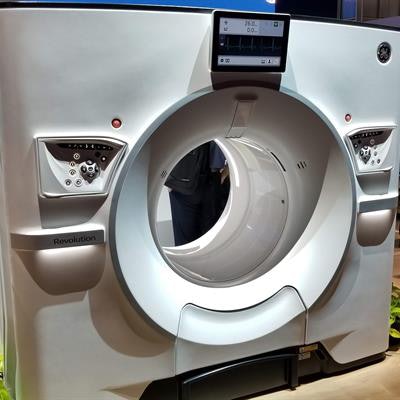
CHICAGO - GE Healthcare is launching a new artificial intelligence (AI) platform called Edison at this week's RSNA 2018 meeting. Other major product launches include a new CT scanner family, a new series of nuclear medicine systems, and workflow tools for MRI, x-ray, and other modalities.
Artificial intelligence
Edison is GE's new AI platform that will tie together the firm's existing AI partnerships and AI applications, many of which are being displayed throughout the company's booth.
GE said that Edison will also enable clinical partners to develop AI algorithms. In addition to bringing together diverse datasets across modalities, vendors, and care settings, the platform features more than 100 developer services, including a tool that tracks the source and usage of AI data in development. Other services address issues such as security, visualization, utilization management, and automatic protocoling, according to the vendor.
In other AI news, GE is highlighting specific AI algorithms being developed in collaboration with academic partners. These algorithms include a pneumothorax application -- developed with four clinical institutions, including the University of California, San Francisco -- and a tool developed with Boston Children's Hospital that allows radiologists to see a side-by-side comparison of age-matched normal childhood brain images along with patients' scans.
The vendor is also sharing progress with its Stroke Management Suites, which now includes machine-learning models that analyze MR and CT images for ischemic and hemorrhagic strokes. GE is developing Stroke Management Suites with Partners Healthcare.
CT
Revolution Apex is being launched as the newest scanner in the company's Revolution product family. The scanner features a new imaging chain and x-ray tube, and it also benefits from GE's Edison deep-learning image reconstruction algorithm.
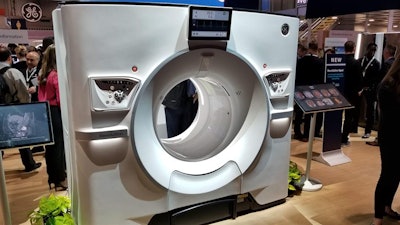 GE's new Revolution Apex CT scanner.
GE's new Revolution Apex CT scanner.Apex introduces GE's new Quantix 160 x-ray tube, which, when combined with Edison reconstruction, enables what GE calls TrueFidelity images with higher spatial resolution and low contrast detectability. Edison reconstruction is being shown as a work-in-progress and does not have 510(k) clearance.
GE is also highlighting the scanner's whole-organ coverage and spectral capability. The system is particularly well-suited for scanning patients with high heart rates, compromised renal function, and high body mass index (BMI).
Also at this year's meeting, GE is bringing to CT the Smart Subscription service that it launched at RSNA 2017. The service enables subscribers to access new CT software for a single annual fee, and it was rolled out last year with GE's adaptive statistical iterative reconstruction (ASIR) V algorithm and Smart MAR metal artifact reduction (MAR) protocol. GE believes Smart Subscription gives users access to the latest technology while improving staff efficiency.
This year, GE is adding five new Smart Subscription packages to the family: a reconstruction package for radiation dose reduction, a package for improving image quality for anatomic details obscured by metal artifacts, and packages for cardiac, brain, and oncology imaging.
GE is also rolling out updates for the Revolution Frontier scanner introduced at RSNA 2017. Revolution Frontier Gen 2 is optimized for oncology imaging and includes SmartView 3D, which provides real-time in-plane needle tracking and GE's Gemstone spectral imaging (GSI) capability to more accurately visualize lesions being biopsied.
Another upgraded scanner, Revolution Evo Gen 2, is a workhorse system that includes the Snapshot Freeze 2.0 cardiac application and FastStroke automated stroke imaging protocol. These applications are also available via Smart Subscription.
MRI
AIRx is an AI-based automated workflow tool for brain scanning that's designed to increase consistency and productivity by producing MR images that have less variability, according to the company. The application is built on GE's Edison deep-learning framework and provides automated slice protocols to eliminate manual, repetitive steps.
 AIRx is an AI-based automated workflow tool for brain scanning.
AIRx is an AI-based automated workflow tool for brain scanning.AIRx is built on a pretrained neural network model and a database of 36,000 images from reference sites and clinical studies; it uses anatomy recognition to define correct anatomic landmarks and automate the scanning process for everything from routine to challenging scans. AIRx is pending clearance from the U.S. Food and Drug Administration (FDA) and is being shown as a work-in-progress.
In other MRI news, GE is expanding its line of adaptive imaging receive (AIR) flexible positioning radiofrequency (RF) coils to additional configurations. The new coils include a 30-channel anterior array coil, a 21-channel multipurpose large coil, and a 20-channel multipurpose medium coil. The coils will be available on GE's 1.5-tesla and 3-tesla scanners.
GE is touting the flexible, blanket-like design of the coils, which are designed to wrap closely around patients for improved image quality. AIR coils are also 60% lighter than conventional coils, the company noted. What's more, AIR Touch software works with the coils to recognize patient anatomy and optimize scans, reducing the amount of patient setup time required.
GE is rolling out new AIR coils on its Signa Premier 3-tesla scanner, as well as new software such as diffusion-weighted imaging (DWI) for the brain and abdomen; hyperband functional MRI, a new DWI technique that simultaneously acquires multiple slices to reduce scan time; and Progres, a distortion correction application.
In liver imaging, GE is showing MyLiver, a workflow application designed to guide users through the full cycle of imaging liver disease. The package includes MyLiver Checkup, which combines MREplus+, a tool for detecting early liver disease in patients. Developed in partnership with Resoundant, the package combines quantitative fat fraction assessment and MR elastography. MREplus+ does not yet have regulatory clearance.
Another liver imaging tool, MyLiverOnco, was developed in partnership with Arterys and is designed for patients with late-stage liver disease, combining AIR coils with fast, free-breathing acquisition protocols. An AI-based analysis tool called Liver AI is designed for visualization, volumetric segmentation, and longitudinal tracking of lesions; it is integrated with the LI-RADS reporting protocol to enable liver lesions to be segmented with a single click.
Women's imaging
In women's imaging, GE is highlighting its Senographe Pristina digital mammography system with Pristina Dueta, a feature that allows patients to control their own breast compression. The self-compression option received FDA clearance in 2017.
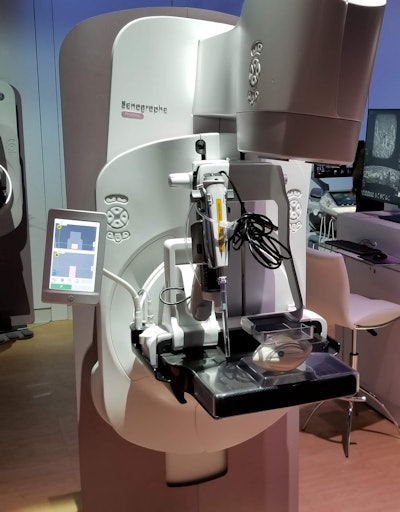 Senographe Pristina from GE.
Senographe Pristina from GE.The company is touting results of a clinical study of 3,503 women that showed that of the 1,814 patients who used Dueta, 63% compressed their breasts more than in their previous traditional mammograms; more breast compression can produce better mammography images, GE noted.
GE is also promoting the low radiation dose of Senographe Pristina for 3D studies, and well as the system's new patient-friendly design, with rounder edges and a thinner image detector to create a more comfortable patient experience.
Other breast imaging tools being highlighted in GE's booth include the Invenia 2.0 automated breast ultrasound (ABUS) system and SenoBright HD contrast-enhanced spectral mammography (CESM) protocol. Both offer different options for working up complex cases, such as women with dense breast tissue.
In addition, GE is directing attention to new tools on its Voluson E10 women's imaging system such as fetalHQ for fast evaluation of the fetal heart. Another new feature, SonoCNS, is an Edison-powered application that automates fetal brain assessment.
Finally, Pristina Serena is a new stereotactic biopsy device that enables Senographe Pristina systems to perform interventional work thanks to an add-on biopsy kit (a 3D option is pending FDA clearance), while Senographe Crystal Nova is a performance-based mammography system that uses the same image detector as Pristina and can perform 18 screening exams per hour. Crystal Nova does not yet have regulatory clearance and is being shown as a work-in-progress.
Imaging informatics
In imaging informatics introductions, GE is showcasing enhancements to its Centricity Universal Viewer and Centricity Clinical Archive. Centricity Universal Viewer now supports breast imaging -- including CT, MRI, and digital breast tomosynthesis (DBT) -- as well as other patient reports such as clinical notes and pathology. Other Centricity Univeral Viewer updates include more immediate access to prior studies, connectivity with most major electronic medical record (EMR) software in the U.S., exam prioritization using cancer detection scores provided by AI analysis of DBT studies powered by partner iCAD, and display of detected malignant soft-tissue densities and calcifications in the DBT images.
In addition, GE has added new features to Centricity Clinical Archive, including embedded analytics for enterprise-wide IT investments, resources, and clinical processes. Its Media Manager application now also includes new multimedia image capture and documentation capabilities for both mobile and desktop devices.
GE is also debuting Imaging Protocol Manager, a cloud-based imaging protocol management service for imaging modalities. With Imaging Protocol Manager, healthcare institutions can ensure that all imaging devices are using the same protocols, according to the firm.
X-ray
In x-ray, GE is showing how it has applied artificial intelligence to radiology's oldest modality with Critical Care Suite, which uses AI algorithms to detect conditions such as pneumothorax on chest x-rays. GE is showing Critical Care Suite at RSNA 2018 on the Optima XR240amx mobile x-ray system as a work-in-progress; 510(k) clearance is pending.
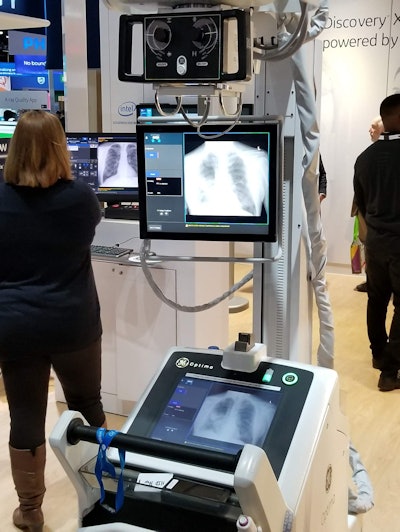 GE is showing Critical Care Suite on the Optima XR240amx mobile x-ray system.
GE is showing Critical Care Suite on the Optima XR240amx mobile x-ray system.Powered by GE's Edison deep-learning framework, Critical Care Suite uses AI technology that is embedded in the mobile x-ray unit; notifications are shared with equipment operators on the system's screen. For example, detection of a pneumothorax generates an alert to the clinical team while prioritizing images from the patient in the PACS image worklist.
Meanwhile, GE is highlighting its Helix advanced image processing technology as a complement to its ultrahigh-resolution FlashPad HD digital radiography (DR) detectors. Helix enables advanced image processing for x-ray cases, with high spatial resolution at a low radiation dose. The combination of Helix and FlashPad HD can improve contrast detectability by up to 40%, according to the company. Helix is available on Optima XR240amx as well as the Discovery XR656 HD fixed radiography system.
Both x-ray systems are also compatible with GE's x-ray quality assurance tool for repeat/reject analysis (RRA). Some imaging facilities in the U.S. are seeing reject rates as high as 25%; the RRA analysis tool can help them reduce this to the benchmark of 5% to 8% by identifying and analyzing the root cause of rejected images.
A final highlight in the x-ray section of GE's booth is Discovery RF 180, a remote system that performs radiography and fluoroscopy, with a 705-lb patient table capacity and 180-cm source-to-image distance, which enables chest exams to be performed without additional equipment.
Molecular imaging
In molecular imaging, GE is showing its MotionFree digital respiratory management technology. MotionFree, which does not require a gating device, can actively monitor respiratory motion in the background of every PET/CT study and clear motion artifacts from every image, according to the vendor. It can also provide real-time respiratory analysis.
GE is also emphasizing its new 800 series of nuclear medicine systems, which were initially introduced at the Society of Nuclear Medicine and Molecular Imaging (SNMMI) 2018 conference in June. The series includes NM 830, NM/CT 850, NM/CT 860, NM/CT 870 DR, and NM/CT 870 CZT.
The firm has also added its Q.Volumetrix MI software to its Xeleris 4 DR nuclear medicine workstation. With Q.Volumetrix MI, clinicians can receive absolute quantitation of tracer uptake to determine how a lesion absorbs the tracer, the company said.
Ultrasound
First unveiled at the European Congress of Radiology in March, Logiq E10 is making its RSNA debut as the company's premium flagship ultrasound scanner. Logiq E10 features integrated AI technology, cloud connectivity, and faster image acquisition and reconstruction algorithms, according to the vendor.
Powered by Edison, the system's Automated Lesion Segmentation tool segments an identified breast, thyroid, or liver lesion and automatically provides a trace of the lesion and corresponding area, helping to eliminate the need to perform manual measurements.
In cardiovascular ultrasound developments, GE is presenting the Imaging Elevated release on its Vivid E95 system, which brings faster volume rates, higher processing power, and smaller probes, according to the vendor. The company is also introducing new apps on its Vscan Extend portable ultrasound system.
Surgical imaging
In surgical imaging, GE is highlighting enhancements to its OEC Elite CFD surgical C-arm portfolio. With a new feature called Live Zoom, clinicians performing vascular, cardiac, and pain management procedures can zoom up to four times on a live image and also take additional fluoroscopy shots or cine runs without changing x-ray technique, according to the vendor. It's operated via touch control and doesn't require any additional radiation exposure, GE said.
The company is also pointing to a new General HD imaging profile for OEC Elite CFD. Designed to make it easier for clinicians to visualize catheters during catheter insertion procedures, General HD softens bone and dense tissue on an x-ray while sharpening the catheter and guidewire outlines, the firm said.
In addition, GE has added a motorized drive configuration for its OEC Elite CFD portfolio. The vendor believes the motorized drive will be particularly useful for vascular and cardiac procedures.
Interventional radiology
In interventional technology developments, GE is showcasing a version of its Discovery IGS 7 multidisciplinary hybrid operating room (OR) designed specifically for neurosurgeons, spine surgeons, and orthopedic surgeons. Previously available for cardiovascular surgeons, Discovery IGS 7 OR features expanded conebeam CT capabilities to accommodate the imaging of patients in complex positions, the company said. It also includes a neurosurgical head holder designed to position a patient's head during neuro or cervical spine procedures.
Discovery IGS 7 OR comes with collision management software to facilitate smooth 2D and 3D imaging throughout neurosurgical procedures, according to the firm. GE said the hybrid OR's wide-bore C-arm and large field-of-view detector can provide high-definition conebeam CT with wide anatomical coverage in one fast spin. In addition, all conebeam CT data can be exported to major navigation systems for neuro or spine procedures, according to the vendor.
GE is also debuting Liver Assist V.I. (Virtual Injection), a dynamic simulation tool designed to help clinicians plan injection points during liver embolization procedures. An Edison application, Liver Assist V.I. automatically highlights vessels in the vicinity of tumors using data from the firm's 3D conebeam CT images. It then maps injection trajectories to help clinicians decide on an injection strategy, the company said.
Liver Assist V.I. comprises Hepatic VCAR and FlightPlan for Liver, which can also be used independently. Liver Assist V.I. requires an AW workstation equipped with the firm's Volume Viewer and Volume Viewer Innova applications.





